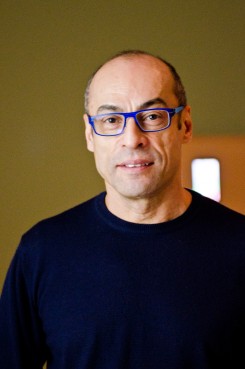An unusual scene greets visitors of the ROM’s “Fresh Flowers” exhibit, a display featuring a collection of drawings by renowned artist David Hockney. A silent film projected onto the wall across from the gallery entrance shows Hockney sitting on a balcony in Paris, working on a sketch of the Eiffel Tower. But there is no stylus or sketchbook in sight. Instead, Hockney uses his thumb to render a soft, hazy outline of the Tower on his latest canvas of choice: Apple’s iPad.
In addition to this short film, “Fresh Flowers” features around 100 of Hockney’s iPad drawings. They are displayed on 25 iPads mounted to the walls of the gallery space, while 20 iPods display a large collection of works that Hockney drew on his iPhone. The exhibit also includes several large-scale animated projections of the iPad drawings, as well as a slideshow with over 150 additional images.

Francisco Alvarez brings David Hockney's Fresh Flowers Exhibit to the ROM.
According to Francisco Alvarez, managing director of the ROM’s Institute for Contemporary Culture, the museum decided to present the exhibit “as an opportunity to explore how a major artist has used new technologies.”
While Hockney’s iPad drawings are certainly innovative, they also represent a natural phase in the evolution of his work. The 74-year-old artist has toyed with popular technologies throughout his career, including Polaroid cameras, computer programs, and even the exterior of a BMW. Hockney’s willingness to experiment with unconventional media has made him a pillar of the pop art movement and has contributed to his reputation as one of the most influential artists of the 21st century.
Hockney began working with Apple products in 2008, when he downloaded a simple painting application called Brushes onto his iPhone. From the comfort of his home in the English countryside, Hockney sketched the vases of flowers that his partner placed on their windowsill each morning, using only his thumb and the Brushes app. Hockney soon began to draw other household objects and then expanded his digital repertoire to include portraits and landscapes. He quickly snatched up the iPad when it was released in 2010, using the larger screen (and eventually a stylus) to hone his technique and enhance the complexity of his drawings.
“The portability of [the device] and the luminosity of the screen are qualities that he really likes about this particular medium,” Alvarez notes. “[In addition to] the fact that he can draw very quickly, and there’s no clean up or mess.”
Soon after he started drawing flowers on his iPhone, Hockney began emailing his sketches to several of his closest friends, including the curator and cultural historian Charlie Scheips, who organized exhibitions of Hockney’s work in London and Paris before bringing the display to Toronto.
Hockney’s use of the iPad has provided an opportunity for museums to create an exhibition as futuristic as the medium itself. The “Fresh Flowers” exhibit at the ROM is WiFi accessible, allowing Hockney to update the display by emailing new drawings directly to the devices in the gallery. But perhaps the most exciting aspect of the exhibit is the collection of 20 drawings that feature playback animations which show the works being drawn from start to finish.
“What’s really interesting about [the playback feature] is entering David Hockney’s mind,” Alvarez says. “It’s not often that you get to observe an artist at work and this is a way of doing that. [The playback] is not exactly in real time because it’s sped up, but you see where his eye is going, what parts of the drawing are most interesting to him … You see his different approaches [to drawing].”
Although Hockney’s use of the iPad has attracted a considerable amount of attention, according to Alvarez, his works actually coincide with a broader trend that sees artists gravitating towards technological media.
“David Hockney’s not the first artist to use the iPad or even the Brushes application,” Alvarez explains. “A lot of artists are actually doing it. The thing is, he’s a big brand name, in a sense, so he gets to be the most prominent figure amongst a whole group of people who are doing both traditional and experimental things with the iPad.”
It is too soon to tell whether this trend will take off and radically change the world of art as we know it. At this point, even Hockney reportedly views his iPad drawings as preparatory sketches as opposed to finished pieces with lucrative potential. But Alvarez asserts they are significant works nonetheless, which illuminate the artist’s ability to both employ and elevate the everyday objects of popular consumption.
“[The iPad] allows [Hockney] to do very quick notes that he can later use to prepare his more important works, which I think are paintings,” he says. “But [his drawings] form a nice body of work in and of themselves as well, and they really illustrate how an artist can take a product which was probably intended to be more of a toy, or a time-waster … and really turn it into something that has a lot more value than the inventor ever might have imagined.”

